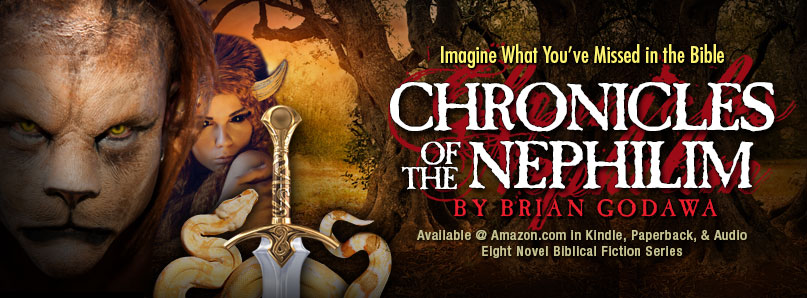In my novels, Joshua Valiant and Caleb Vigilant, I write about a tribe called the Seirim people of Banias at Mount Hermon. They live in caves at the foot of the mountains and are led by satyrs, chimeric beings with the lower body of a goat and the upper body of a human. But this mythopoeic imagery is not a mere assimilation of ancient Greek myths about Pan, the satyr deity of nature and shepherding. The notion of satyrs or goat deities predates Greek myth and finds a place in Canaanite lore, and therefore, the Bible as well.
Take a look at these prophecies of Isaiah referencing the destruction of Babylon and Edom.
Isaiah 34:11–15 (The destruction of Edom)
11But the hawk and the porcupine shall possess it, the owl and the raven shall dwell in it… 13Thorns shall grow over its strongholds, nettles and thistles in its fortresses. It shall be the haunt of jackals, an abode for ostriches. 14And wild animals shall meet with hyenas; the wild goat (seirim) shall cry to his fellow; indeed, there the night bird settles and finds for herself a resting place. 15There the owl nests and lays and hatches and gathers her young in her shadow; indeed, there the hawks are gathered, each one with her mate.Isaiah 13:21–22 (The destruction of Babylon)
21But wild animals will lie down there, and their houses will be full of howling creatures; there ostriches will dwell, and there wild goats (seirim) will dance. 22Hyenas will cry in its towers, and jackals in the pleasant palaces; its time is close at hand and its days will not be prolonged.
The passages above speak of God’s judgment upon the nations of Babylon and Edom (symbols of all that is against Israel and Yahweh). A cursory reading of the texts seem to indicate a common word picture of Yahweh destroying these nations so thoroughly that they end up a desert wasteland with wild animals and birds inhabiting them because the evil people will be no more.
Nothing about mythical monsters like satyrs there, right?
Wrong. Because the English translations of the Hebrew word seirim as “wild goats,” obscure the full ancient meaning. If we look closer into the original Hebrew, we find a more expanded mythopoeic reference to pagan deities.
A quick look at the Septuagint (LXX) translation into Greek made by ancient Jews in the second century before Christ, we find the hint of that different picture.
Isaiah 34:13-14 (LXX)
11 and for a long time birds and hedgehogs, and ibises and ravens shall dwell in it: and the measuring line of desolation shall be cast over it, and satyrs shall dwell in it…13 And thorns shall spring up in their cities, and in her strong holds: and they shall be habitations of monsters, and a court for ostriches. 14 And devils shall meet with satyrs, and they shall cry one to the other: there shall satyrs rest, having found for themselves a place of rest.[1]Isaiah 13:21-22 (LXX)
But wild beasts shall rest there; and the houses shall be filled with howling; and monsters shall rest there, and devils shall dance there, 22 and satyrs shall dwell there.[2]
Wow, what a dramatic difference, huh? Of course, the LXX passages above are not in Greek, but are English translations, which adds a layer of complication that we will unravel shortly to reveal even more mythopoeic elements. But the point is made that ancient translators understood those words within their ancient context much differently than the modern bias of more recent interpreters. Of course, this does not necessarily make the ancient translators right all the time, but it warrants a closer look at our own blinding biases.
 The LXX translates the word for “satyrs” that appears in these Isaiah passages as onokentaurois or “donkey-centaurs,” from which we get our word “centaur.” The Greek-English Lexicon of the Septuagint defines this word as “donkey-centaur, mythic creature (a centaur resembling a donkey rather than a horse).”[3]
The LXX translates the word for “satyrs” that appears in these Isaiah passages as onokentaurois or “donkey-centaurs,” from which we get our word “centaur.” The Greek-English Lexicon of the Septuagint defines this word as “donkey-centaur, mythic creature (a centaur resembling a donkey rather than a horse).”[3]
In Isaiah 34:14 of the ESV we read of “the wild goat crying to his fellow,” and in 13:21, “there wild goats will dance.” But the underlying Hebrew (seirim) is not about wild goats, but satyrs, that were prevalent in Canaanite religion. Scholar Judd Burton points out that Banias or Panias at the base of Mount Hermon in Bashan was a key worship site for the Greek goat-god Pan as early as the third century B.C. and earlier connections to the goat-idol Azazel.[4]
Satyrs were well known for their satyrical dance, the Sikinnis, consisting of music, lascivious dance, licentious poetry and sarcastic critique of culture.[5] This reflects the mockery of the goats dancing on the ruins of Edom and Babylon in Isaiah, and the Sikinnis finds its way also into Joshua Valiant of the Chronicles.
The Bible writers considered these pagan seirim deities to be demons and thus called them “goat demons.” So prevalent and influential were these satyr gods that Yahweh would have trouble with Israel worshipping them as idols.
Leviticus 17:7
7 So they shall no more sacrifice their sacrifices to goat demons (seirim), after whom they whore. This shall be a statute forever for them throughout their generations.2 Chronicles 11:15
15 [Jeroboam] appointed his own priests for the high places and for the goat idols (seirim) and for the calves that he had made.
Not only did Israel fall into worshipping the seirim in Canaan, they were even committing spiritual adultery with them while in the wilderness! It is no wonder Yahweh considered them demonic, a declaration reiterated in Moses’ own prophecy that after Israel would be brought into Canaan by the hand of God, she would betray Yahweh by turning aside to other gods, redefined as demons.
Deuteronomy 32:17
17 They sacrificed to demons that were no gods, to gods they had never known, to new gods that had come recently, whom your fathers had never dreaded.[6]


